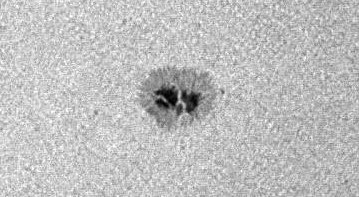 Where's Saturn? Is that a UFO--or the ISS? What's the name of that star? Get the answers from mySKY--a fun new astronomy helper from Meade. Where's Saturn? Is that a UFO--or the ISS? What's the name of that star? Get the answers from mySKY--a fun new astronomy helper from Meade. SOLAR WIND: Earth is entering a solar wind stream that could trigger a mild geomagnetic storm. High-latitude auroras will be difficult to see, however, because of interference from the summer sun. UPDATE: Faint green auroras were visible from Canada this morning. Stephane Levesque of Ste Luce, Quebec, captured them in a 20 second exposure at 800 ASA: image. FRACTURING SUNSPOT: Sunspot 961 is breaking apart. Pavol Rapavy of Rimavska Sobota, Slovakia, took this picture of the fracturing spot on July 3rd: 
UPDATE: Click to view a three-day animation
The spot's dark core is about as wide as Earth, so we are witnessing the breakup of something as big as a planet. The next 24 hours could prove eventful; solar astronomers, ready your telescopes. more images: from Michael Borman of Evansville, Indiana; from John C McConnell of Maghaberry Northern Ireland; from C. LaCroix, B. Smith, R. Espanoza, S. Hatfield, B. Morrissette and J. Stetson of South Portland, Maine; from Maxim Usatov of Dniepropetrovsk, Ukraine; from Robert Arnold on the Isle of Skye, Scotland; PLANETS AND FIREWORKS: When the sun sets tonight, fireworks will flare across the USA. It's Independence Day. Among the explosions, you can do a little astronomy. In the east, there is Jupiter: 
Photo details: Canon Digital Rebel XTi, 800 ASA, 7s
Joan Skelton took this picture of the giant planet and fireworks above Ontario harbour on July 1st--Canada Day. A small telescope reveals Jupiter's largest moons, its equatorial bulge and suddenly changing cloud belts. On the other side of the sky (look west) lies Venus, shown here in a June 30th photo from John Sachs of Hanover, Pennsylvania. "Venus and fireworks--what a beautiful sight," he says. The same small telescope shows this planet's surprising shape. Like the Moon, Venus has phases and at the moment it is a tiny crescent. Take a look!
2007 Noctilucent Cloud Gallery
["Noctilucent Cloud"--the song] [Night-Sky Cameras] | 
